Revlon (post 1960)
Continued from: Revlon (1945-1960)
Revlon’s 1960 annual report was glowing. Consolidated net sales had risen to US$136,372,587, up from US$124,939,712 the previous year, and the share price was strong. In January, 1961, the directors voted for a two-for-one stock split, a decision approved by shareholders at the Annual General Meeting. Charles Revson and Charles Lachman had already benefited from the strong share price , collectively selling 130,000 Revlon shares.
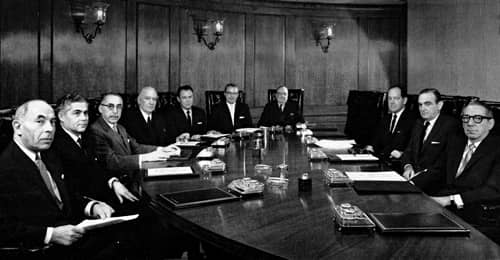
Above: 1962 Revlon board meeting.
The report also noted the purchase of the Realistic Company of Cincinnati, Ohio, a salon supplier of professional salon products that included permanent waves, shampoos, conditioners, hair sprays and hair dressings, founded in 1925 by Philip D. Spaeth.
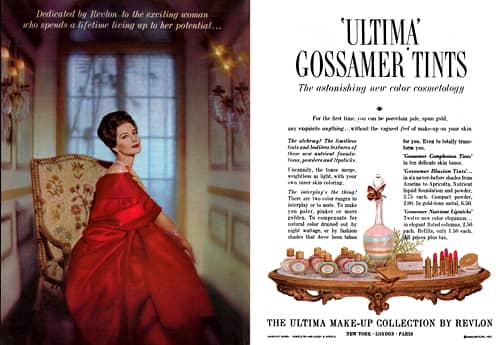
Above: 1960 Revlon Ultima Make-up Collection.
On the product front, 1960 saw Revlon introduce the Ultima make-up collection of liquid foundations, powders and lipsticks, establish the Moon Drops line, and expand the shade range of its Eye Maker à la Carte line. The spring and fall colour promotions for Revlon lipsticks and nail enamels featured Pango Peach and Berry Bon Bon with Pango Peach released simultaneously in New York, Paris and London, a first for an American cosmetic company.
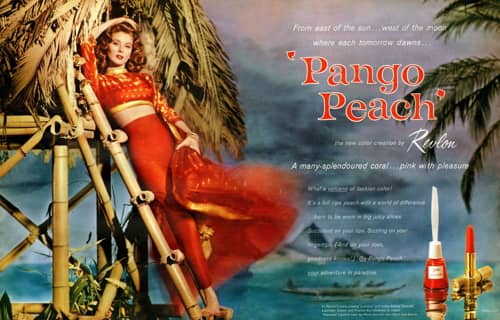
Above: 1960 Pango Peach
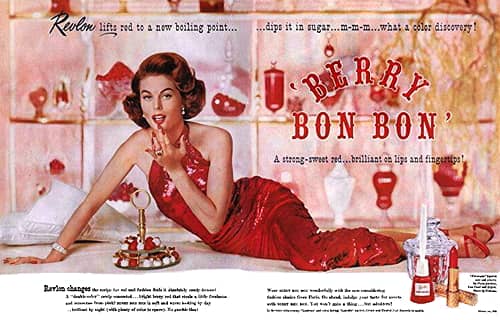
Above: 1960 Berry Bon Bon.
Multiline cosmetics
The creation of the Ultima and Moon Drops ranges was a further development of the ‘flankers’ idea Revlon had first used in the 1950s. By 1970, Revlon had six semi-autonomous cosmetic lines each with its own product range and management team: Revlon, Moon Drops, Ultima II, Natural Wonder, Etherea and Princess Marcella Borghese.
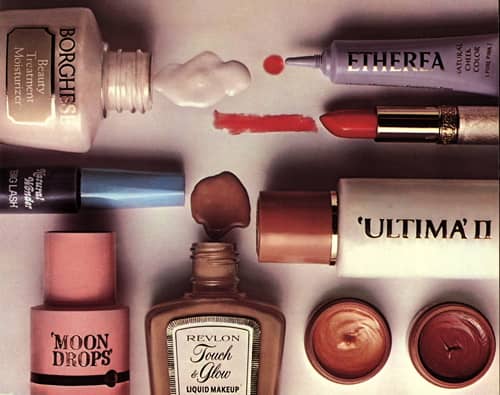
Above: 1971 Revlon cosmetic lines.
A company report from 1973 suggests that this was part of a comprehensive business strategy begun in 1967.
The strategy grew out of an extensive study which revealed that although cosmetics was a mass market, it was not a homogeneous one. The market consisted of large segments of women who differed from each other in subtle but vital respects. Women’s cosmetics brand preferences, the amounts they spent and the stores they shopped were largely determined by their attitudes about themselves—their identities. And since no one identity could fit all women, no one brand could fill all women’s complete cosmetic needs. Research further indicated that Revlon’s continued industry leadership depended on its ability to properly serve each major identity segment with a distinct product line appropriate to its specific needs.
Creating those major lines or “houses” effectively lead us to develop six autonomous businesses each complete with its own products, management team, distribution pattern, marketing plan and profit responsibility.(Revlon Annual Report, 1973, p. 7)
Looking at the six lines in question it seems hard to believe that their creation was part of a coherent, long-term plan: Revlon, Moon Drops and Princess Marcella Borghese were begun well before 1967; Natural Wonder and Etherea were developed quickly in response to activities by other companies; and Ultima II was created because Charles Revson wanted to be in the prestige cosmetics business.
1. Revlon
The company’s original range consisted of make-up lines such as Touch & Glow (1950), Love Pat (1953), Liquid Asset (1957) and Waking Beauty (1953) as well as Revlon Nail Enamels and Lipsticks.
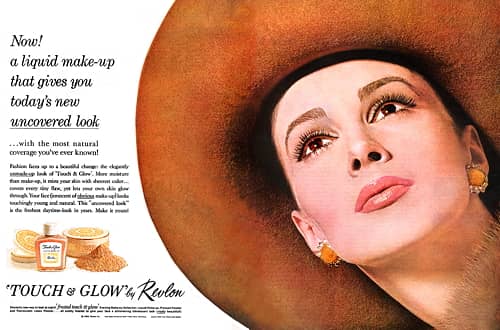
Above: 1963 Revlon Touch and Glow.
Make-up
New make-up additions introduced in the 1960s included: Contempera, a powder, moisturiser and foundation packed in a tube, Eye Velvet, a moisturising, fluid, creamy eye shadow, and Super Lustrous II lipstick in twenty-five of Revlon’s best-selling shades (1961); Sculptura slim line lipstick, and Wonder Cover, a concealer (1962); Fabulash, an eyelash-extending mascara (1963); and Face Gleamer, a transparent blusher stick (1967).
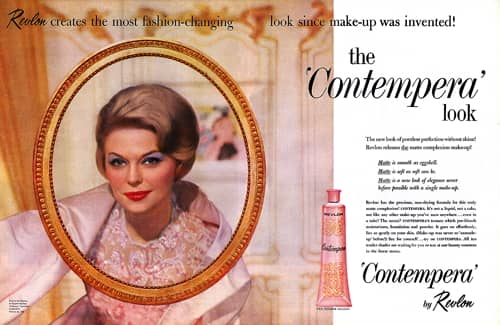
Above: 1964 Revlon Contempera.
Contempera: “The all-in-one make-up in a tube . . . for the flawless matte finish.” Shades: Cream Beige, Creamy Ivory, Creamy Peach, Dark Rachel, Golden Toast, Light, Misty Rose, Rachel, Suntan, and Tropic Tan.
Eye Velvet: “Matt is velvety. Never shiny, greasy or harsh. … Better than dry powders that cake, emphasize lines. Better than smeary sticks that settle in creases and fade.” Shades: Blue Snowdrop, Teal Blossom, Brown Ash, Turquoise Petal, Fresh Emeralds, Lilac Heather, Bluebud, Aqua Fern, Fresh Emeralds Lameé, Lilac Heather Lameé, Bluewillow Lameé, and Aqua Fern Lameé.
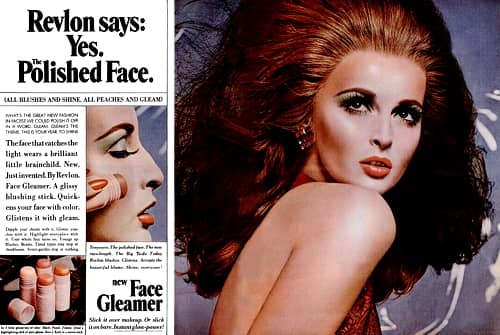
Above: 1967 Revlon Face Gleamer
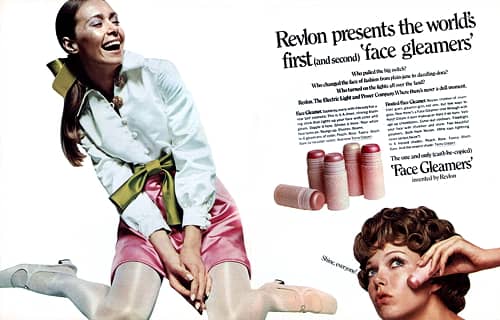
Above: 1969 Revlon Face Gleamer and Frosted Face Gleamer each in Peach, Rose, Tawny, Blush, Terra Cotta and Bare shades.
Face Gleamer: “Gives your skin a warm, glowing lift of color, and a healthy helping of shine.” Shades: Blush, Peach, and Tawny, with Bare, a highlighting stick.
Fabulash: “[C]ontains little, lash-like ‘filaments’ that latch right on to your own lashes–adding silky, natural-looking length in just one application.” Shades: Black, Dark Brown, and Dark Blue.
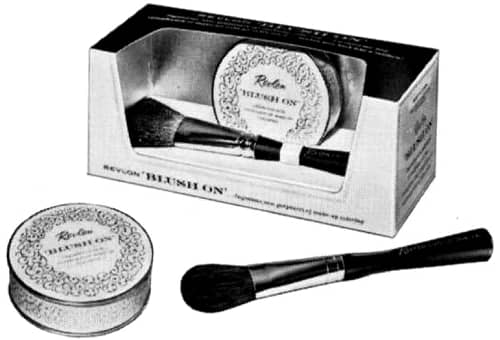
Above: 1962 Revlon Brush-On.
Revlon also introduced a number of powder-based brush-on cosmetics starting with Blush-On (1962) which came with a powder brush, followed by Brush-On Eyeshadow, and Brow Beautiful (1964), and Sweeping Beauty (1965). Collectively known as ‘The Beautiful Young Brush-Ons’ these were part of Revlon’s response to the ‘natural look’ make-up trend.
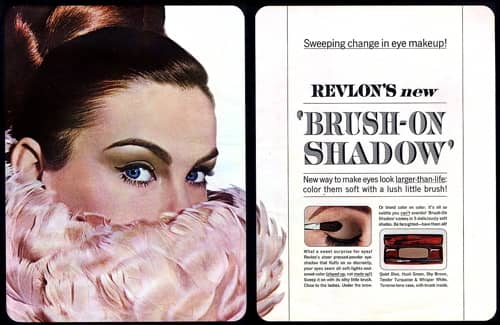
Above: 1965 Revlon Brush-On Shadow.
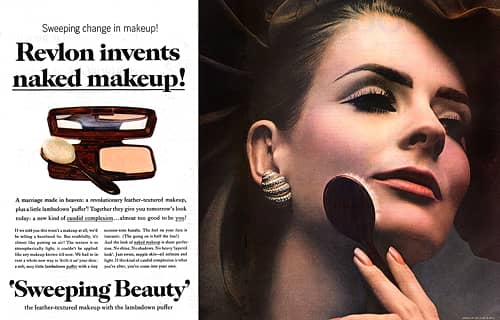
Above: 1965 Revlon Sweeping Beauty.
Blush-On: “For a glow of ‘instant health’ all over your lace—it’s Revlon’s makeup miracle.” Shades: Tawny Pink, Misty Pink, and Honey Amber.
Brush-On Eyeshadow: “[P]ressed powder eyeshadow (frosted or not] in lash colors that are softened to a hush.”
Brow Beautiful: “[B]rush-on eye-brow color that does everything a pencil can do—only softer.”
Sweeping Beauty: “Feather-textured makeup for a new candid complexion—almost too good to be you!”
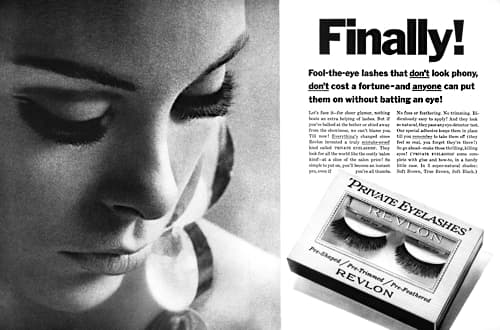
Above: 1966 Revlon Private Eyelashes. In Soft Brown, True Brown, and Soft Black shades produced by the British company, Eylure.
Revlon continued to add new shades of lipstick and nail enamel, either in spring and fall promotions or in larger colour collections. Those that I know of are: Honey Bee Pink, and Louis XIV Red (1961); Sphinx Pink, Million Dollar Red, and Colors Avant Garde (Naked Pink, Bare Beige, Madly Mauve, Swinging Pink, Blasé Apricot, Low Down Pink, Beach Pink, Pink Cognito, Nouveau Peach, and Super Natural) (1962); Jungle Peach, Stormy Pink, and Colors on the Naked Side (Barely Pink, Barely Strawberry, Barely Tan, Barely Peach, Barely Orange, and Barley Ivory) (1963); Fingertip Tans (Pink Sand, Driftwood Tan, Tan Tan, Butter Pecan, Sugar Blonde, Rose Gold, Bare Beige, Barely Tan and Bamboo White), Tawny Look (Tawny Coral, Tawny Rose and Tawny Pink), and La Dolce Look (Coralissima, Passionate Pink, and Caramella) (1964); The Earthy Ones (Bricktop, Terra Rosa, and Camel), and The Worldly Young Innocents (Little Red Red, Sugar Beige, and Pussycat Pink) and Frosted Translucents (Softsilver Red, Softsilver Pink, Softsilver Rose, Softsilver Coral, Softsilver Beige, Sugar and Ice, and Frosted Melt) (1965); Fabulous Frostings (Glazed Peach, Sugar Bisque, Snowpoppy, Orangerine, Mocha Mauve, Glittersweet Pink, Almond Ice, Silver Nougat, and Candied Violet) (1966); Fiery Frostings (Silverplum, Snow Orange, Glittermelon, Pinkfoil, Copperfrost, and Strawberry Ice) and The Beautiful Blazers (Mister Melon, Blazer Pink and Copper Cane) (1967).
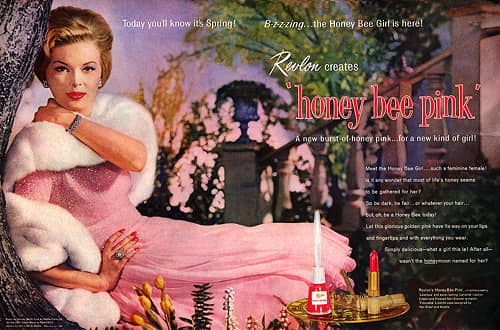
Above: 1961 Honey Bee Pink.
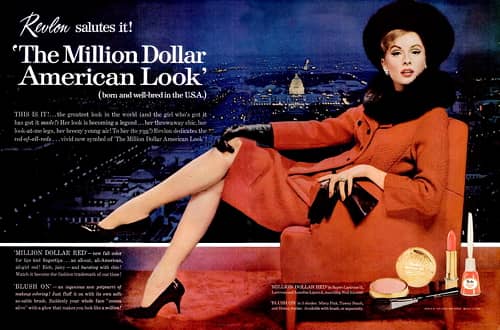
Above: 1962 The Million Dollar American Look.
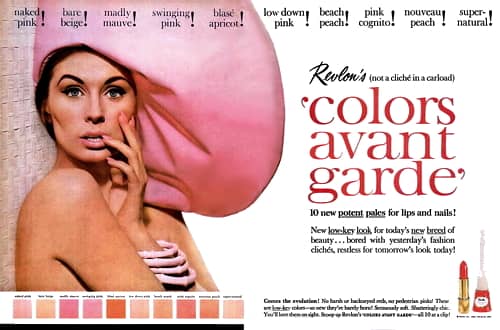
Above: 1962 Colors Avant Garde.
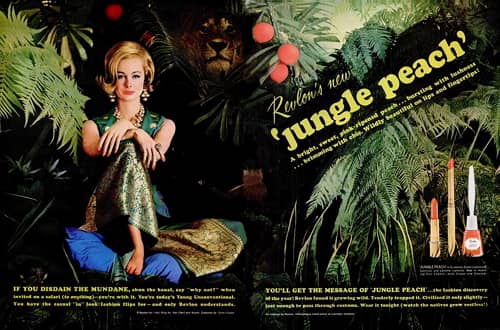
Above: 1963 Jungle Peach.
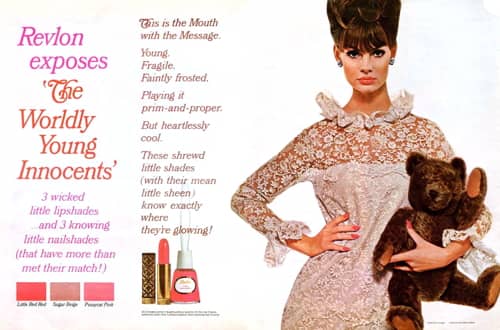
Above: 1965 The Worldly Young Innocents.
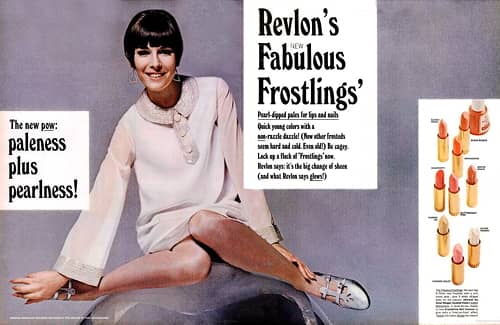
Above: 1966 Revlon Fabulous Frostings in Glittersweet Pink, Snowpoppy, Orangerine, Glazed Peach, Mocha Mauve, Sugar Bisque, Almond Ice, Silver Nougat, and Candied Violet shades.
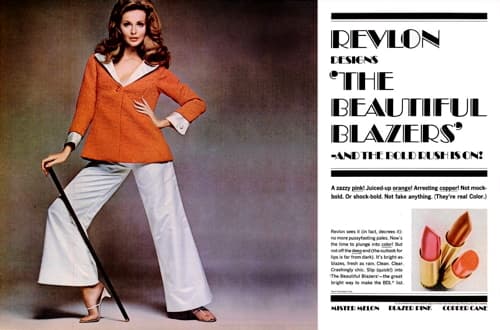
Above: 1967 The Beautiful Blazers.
Also see: The Complete Guide to Make-up by Revlon (c.1965) and Tips on Shade Selection (c.1965)
Skin-care
The Revlon range also included some new skin-care cosmetics. The first of these was Eterna 27 (1961), a skin cream containing pregnenolone acetate, an ester of the hormone precursor pregnenolone trademarked as Progenitin. Company advertising for Eterna 27 disclaimed that the product contained hormones which avoided problems with the American Food and Drug Administration (FDA), unlike Rubinstein’s Ultra Feminine Face Cream (1959).
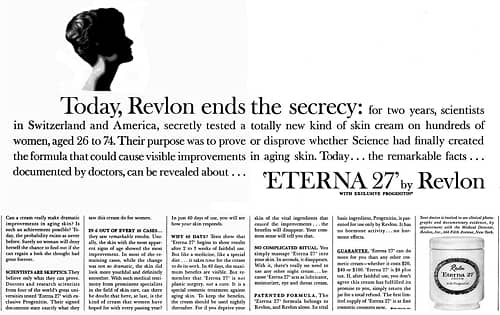
Above: 1961 Revlon Eterna 27.
Eterna 27: “[W]orld-famed skin specialists proved ‘Eterna 27’ brought dramatic changes to the skin in more than 6 out of every 10 cases they tested! (And the skin most in need of help usually showed the most remarkable response.) And remember, there are no hormones in ‘Eterna 27’.”
See also: Hormone Creams, Oils and Serums
In 1964, Revlon expanded Eterna 27 into a collection adding Eterna 27 Cleansing Formula, Skin Moisturising Formula, Skin Toning Formula and Facial Masque Formula.
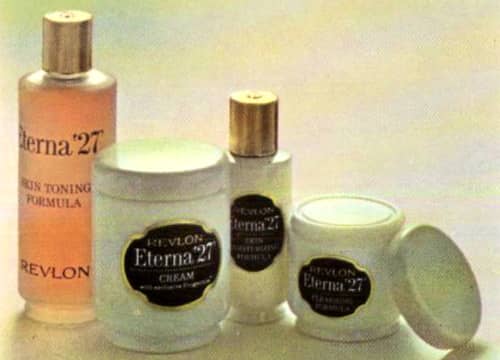
Above: 1965 Revlon Eterna 27 Treatment Collection.
A second product was Wonderlift (1964), an albumin wrinkle smoother similar to the controversial Magic Secret released by Helene Curtis earlier in the year.
Wonderlift: “Probably the most effective method yet discovered to make wrinkles, expression lines and crowsfeet fade from sight for those special hours when its wildly important to look your best.”
See also: Albumin Wrinkle Smoothers
Hands and nails
Revlon continued to produce a wide range of cosmetics to care for the hands and nails.
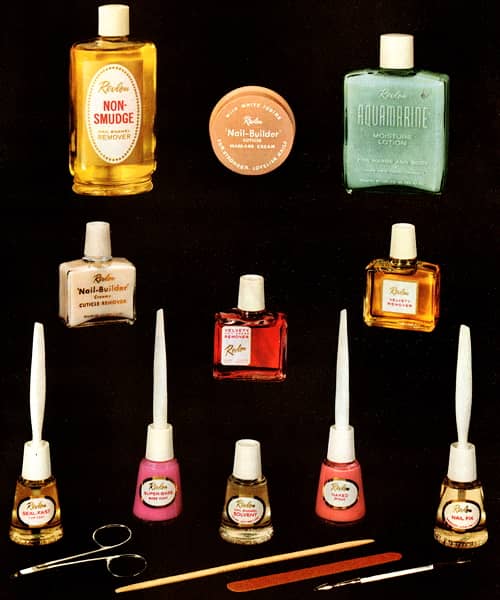
Above: c.1962 Revlon hand and nail-care range.
Back: Non-Smudge Nail Enamel Remover, Nail-Builder Cuticle Massage Cream, and Aquamarine Moisture Lotion for Hands and Nails. Middle: Nail-Builder Creamy Cuticle Remover, Velvety Non-Smear Remover, and Velvety Remover. Front: Seal-Fast Top Coat, Super-Base Base Coat, Nail Enamel Solvent, Nail Enamel (Naked Pink shade), Nail Fix, and assorted manicure equipment.
See also: The Revlon Guide to Nail Care (c.1962)
The House of Revlon
Revson’s concern about the declining status of the Revlon brand led him to open the House of Revlon salon on the second floor of the Gotham Hotel on the corner of 55th Street, New York in May, 1961. The salon garnered a good deal of media attention when it opened, and was frequented by many well-heeled but temperamental clients, but it is unlikely that it ever paid its way from the day it opened until the day Revson shut it down in 1972. It also failed to reposition Revlon as a high-status line.
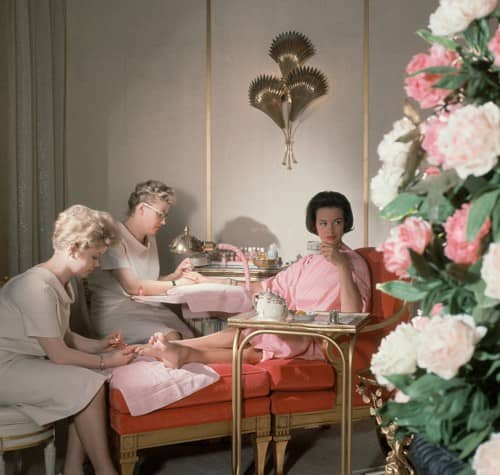
Above: 1961 Gloria Vanderbilt [1924-2019] getting a manicure and pedicure at the House of Revlon. Vogue ran a four-page pictorial of the salon in its August 15 issue in which Gloria Vanderbilt played a typical client. She also had her hair and make-up done before changing her clothes – attendants pressed and packed a client’s day clothes and delivered them to her home so that she could get dressed and go out for the evening directly from the salon.
2. Moon Drops
As mentioned earlier, the Moon Drops range began in 1960 when Moon Drops Moisturizing Cleanser and Moon Drops Facial Freshener were added to the preexisting Moon Drops Moisture Balm (1953) and Moon Drops Moisture Foundation (1958). Initially, products in the range were restricted to skin-care but the line quickly moved into make-up after the addition of Moon Drops Lipstick in 20 shades in 1964.
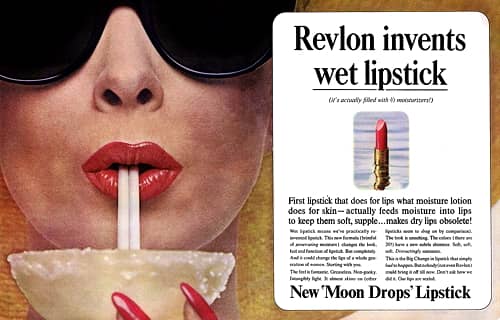
Above: 1965 Revlon Moon Drops Lipstick.
Other products added through to 1970 included: Moon Drops Extra Emollient Moisture Balm (1962); Moon Drops Moisture Balm for Dry, Dry Skin, Moon Drops Toning Lotion for Sensitive Skin, Moon Drops Moisturizing Bath Oil, and Moon Drops Firming Facial Mask (1964); Moon Drops Body Massage Lotion, and Moon Drops Moisture Cream (1965); Moon Drops Blushing Silk Moisturiser plus Color (1966); Moon Drops Demi-Make-Up (1967); Moon Drops Demi Facecare, and Moon Drops Demi Lipsticks (1968); Moon Drops Luminesque Cream Blusher (1969); Moon Drops Great Glissers, and Moon Drops Luminesque Lipsticks (1970).
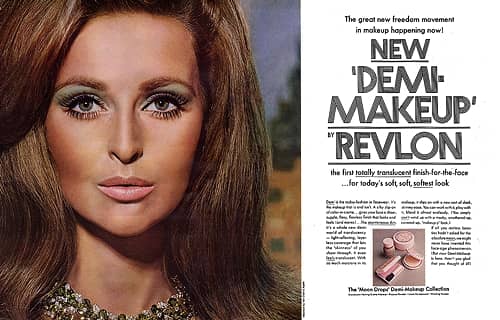
Above: 1967 Revlon Moon Drops Demi-Make-up.
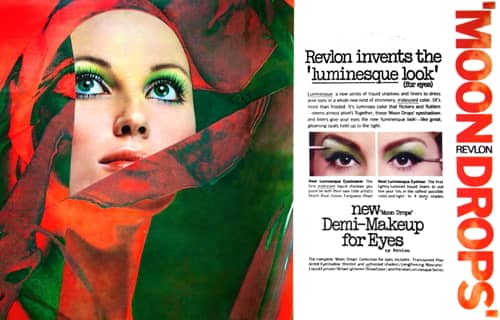
Above: 1967 Revlon Moon Drops Demi-Make-up for Eyes.
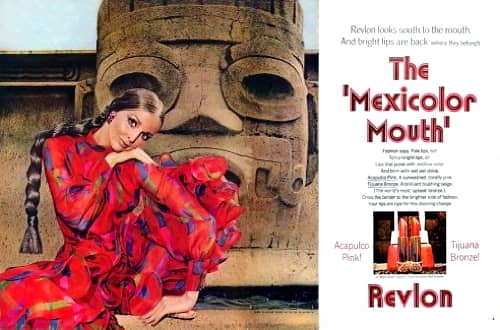
Above: 1969 Revlon Moon Drops ‘Mexicolor Mouth’ – Acapulco Pink and Tijuana Bronze.
Moon Drops Moisturizing Cleanser: “[A] superb preparation for deep-pore cleansing plus moisturizing.”
Moon Drops Facial Freshener: “[T]ones, firms, and refines pores.”
Moon Drops Moisture Foundation: “Non-greasy foundation that is transparent on the skin, quickly absorbed. Working under make-up it helps protect the skin from losing precious moisture. Also provides a base which helps foundation glide on more smoothly and powder cling longer. Can be used by oily skins for overnight moisturizing.”
Moon Drops Moisture Balm: “A richer, non-greasy night cream that works as you sleep to help replace and retain moisture on the skin. A delicately scented flowing cream, Moon Drops Moisture Balm is transparent on the skin, quickly absorbed, does not stain clothing or pillow case. Extra dry skin can use it as a base under make-up.”
Moon Drops Moisture Balm for Dry, Dry Skin (Extra Dry Skin): “A super-rich version of Moon Drops created as a flowing night cream for dry and extra dry skins. It glides on smoothly, absorbs quickly and easily, leaving a thin emollient film on the surface of the skin to help preserve precious moisture.”
Moon Drops Moisture Cream: “This moisture works from within—through the night—to help rescue your skin from dryness. Use it faithfully. Your skin will wake up looking rested and replenished . . . deliciously fresh and springy to the touch.”
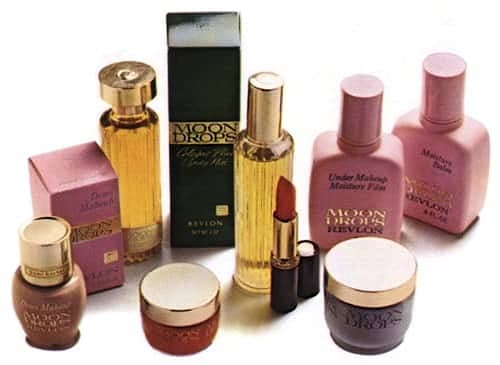
Above: 1973 Moon Drops.
Renaissance Treatment Collection
By 1964 Revlon had skin-care regimes for Normal, Oily, Dry, and Extra Dry skin types using cosmetics primarily from the Revlon and Moon Drops ranges.
See also: The Complete Guide to Skin Care (1964)
In 1965, Revlon combined many of the products used in its previous skin-care routines to create the Renaissance Treatment Collection – advertised as the ‘most complete Beauty Care Program ever developed’.

Above: Renaissance Treatment Collection.
Products included in the collection were as follows:
Cleansers: Moon Drops Moisturizing Cleanser, Clean & Clear Cleansing Lotion, and Clean & Clear Cleansing Lotion for Extra Dry Skin.
Conditioners: Liquid Asset Conditioner and Freshener, Moon Drops Toning Lotion for Sensitive Skin, and Moon Drops Facial Freshener.
Stimulants: Build-Up Firming Facial, and Moon Drops Facial Mask.
Moisturisers: Moon Drops Moisture Foundation.
Lubricants: Eterna 27 Cream, Moon Drops Moisture Balm, Moon Drops Moisture Balm for Extra Dry Skin, Waking Beauty Night Cream, and Seven Wonders Night Cream for Extra Dry Skin.
As, before, these products were then organised into treatment regimes for Normal, Oily, Dry and Extra-Dry skin types.
if your skin is NORMAL . . .
In the morning:
CLEANSE with ‘Moon Drops’ Moisturizing Cleanser
FRESHEN with ‘Moon Drops’ Facial Freshener
During the day under make-up:
MOISTURIZE with ‘Moon Drops’ Moisture Foundation
At bedtime:
CLEANSE with ‘Moon Drops’ Moisturizing Cleanser
CONDITION with ‘Liquid Asset’ Conditioner and Freshener
LUBRICATE with ‘Moon Drops’ Moisture Balm
Twice a week:
STIMULATE with a Build-Up’ Firming Facial.
if your skin is OILY . . .
CLEANSE with ‘Clean and Clear’ Cleansing Lotion
FRESHEN with ‘Moon Drops’ Facial Freshener
During the day under make-up:
MOISTURIZE with ‘Moon Drops’ Moisture Foundation
At bedtime:
CLEANSE with ‘Clean and Clear’ Cleansing Lotion
CONDITION with ‘Liquid Asset’ Conditioner and Freshener
LUBRICATE with ‘Moon Drops’ Moisture Foundation
Three to four times a week:
STIMULATE with ‘Build-Up’ Firming Facial.
if your skin is DRY . . .
CLEANSE with ‘Moon Drops’ Moisturizing Cleanser
FRESHEN with ‘Moon Drops’ Toning Lotion for Sensitive Skin
During the day under make-up:
MOISTURIZE with ‘Moon Drops’ Moisture Foundation
At bedtime:
CLEANSE with ‘Moon Drops’ Moisturizing Cleanser
FRESHEN with ‘Moon Drops’ Toning Lotion for Sensitive Skin
LUBRICATE with ‘Moon Drops’ Moisture Balm or ‘Eterna 27’ Cream (if your skin is showing the effects of aging)
Twice a week:
STIMULATE with ‘Moon Drops’ Facial Mask.
if your skin is EXTRA-DRY . . .
CLEANSE with ‘Clean and Clear’ Cleansing Lotion for Extra-Dry Skin
FRESHEN with ‘Moon Drops’ Toning Lotion for Sensitive Skin
During the day under make-up:
MOISTURIZE with ‘Moon Drops’ Moisture Balm
At bedtime:
CLEANSE with ‘Clean and Clear’ Cleansing Lotion for Extra-Dry Skin
FRESHEN with ‘Moon Drops’ Toning Lotion for Sensitive Skin
LUBRICATE with ‘Moon Drops’ Moisture Balm or ‘Eterna 27’ Cream
Once a week:
STIMULATE with ‘Moon Drops’ Facial Mask.Revlon, c.1965, pp. 2, 5, 7 & 10)
See also: The Revlon Guide to Beauty Treatment (c.1965)
3. Princess Marcella Borghese
After a rather hesitant start in 1958, the Borghese line continued to be supported and extended after 1960 as part of Revson’s strategy to sell high-end, more exclusive cosmetics in department stores. However, it failed to protect Revlon from Estée Lauder’s encroachment into this space.
Products in the range included: Lip Brillante lipsticks with matching Nail Cristallo and Nail Glaciale (frosted) nail enamels (Shades: Granato, Rubino, Corallo, Zaffiro, Ametista, Opale Rosa, Perla Nebbia, Arancia Fiamma, Oro Fiorentino, and Argento Fiorentino with later additions including Giotto Pink, Neapolitan Coral, Vivida Rosa, Bianco Brillante and Bianco Perla); Collezione Luminosa custom formula make-up (Velluto, a liquid make-up, Lustre, a powder and Solida, a pressed powder); and Liquid Eye Accent (eyeshadow, eyeliner and mascara); with body treatments added to the line in 1966 and the Borghese Garden Collection using extracts of fruits and vegetables introduced in 1971. The widespread use of Italian sounding names was supposed to give the impression that the cosmetics were imported from Italy even though they were actually developed and made in the United States.
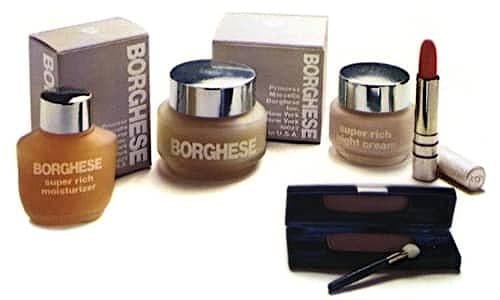
Above: 1973 Princess Marcella Borghese.
4. Natural Wonder
In January, 1961, the Noxzema Chemical Company of Baltimore, Maryland released its new Cover Girl make-up range medicated with hexachlorophene. Beginning with Cover Girl Liquid Make-up and Cover Girl Pressed Powder the company followed up with Cover Girl Face Powder later in the year and Cover Girl Matte Make-up in 1962. Despite the fact that the line was very limited and only came in three shades, a slick advertising campaign meant that it sold well to its target youth market and the line was expanded into the successful make-up and skin-care range that it is today.
See also: Cover Girl and Hexachlorophene
Revlon was not well represented in the youth market and the success of Cover Girl led Revlon to launch Natural Wonder in 1962. Like Cover Girl, the Natural Wonder line was an economy cosmetics brand, was also medicated with hexachlorophene and came as a liquid, matte and pressed powder – Natural Wonder Medicated Liquid Make-up, Medicated Matte Make-up and Pressed Powder. The range came in seven shades increased to ten by 1964: Light, Misty Rose, Creamy Ivory, Cream Beige, Soft Beige, Tawny Beige, Toasted Beige, Creamy Peach, Rachel, and Suntan.
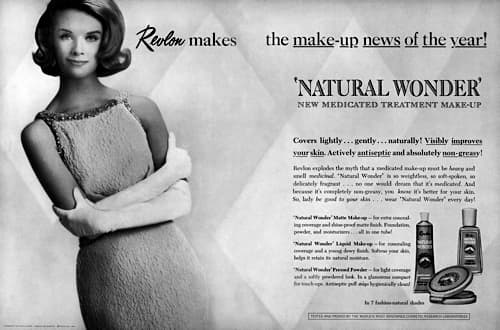
Above: 1962 Revlon Natural Wonder.
Natural Wonder Pressed Powder: “[F]or light coverage and a soft powdered look. In a glamorous compact for touch-ups. antiseptic puff stays hygienically clean!“
Natural Wonder Liquid Make-up: “[F]or concealing coverage and a young dewy finish. Softens your skin. Helps retain its natural moisture.“
Natural Wonder Matte Make-up: “[F]or extra concealing coverage and shine-proof matte finish. Foundation, powder, and moisturizers . . . all in one tube!”
In 1964, Revlon extended Natural Wonder with Natural Wonder Medicated Cake Make-up, Disposable Medicated Cleansing Pads, Total-Care Skin lotion, and Medicated Blemish Stick.
Natural Wonder Medicated Cake Makeup: “It’s the most in coverage! Speeds up the healing . . . and it’s ultra-concealing! Smooths on with its own special sponge.” Shades: Misty Rose, Creamy Ivory, Cream Beige, Soft Beige, Tawny Beige, and Rachel.
Natural Wonder Disposable Medicated Cleansing Pads: “Use one, then throw it away. (No danger of re-infection!) They come in a slim purse pack, so you can clean and protect your skin any time, any place . . . really give it the full treatment.”
Natural Wonder Total-Care Skin Lotion: “Clear medicated liquid cleans, treats and protects! Stops blemishes better than a whole routine of creams and astringents!”
Natural Wonder Medicated Blemish Stick: “Helps to hide and heal trouble spots. And of course, it’s flesh-toned, so you can use it solo or under makeup.”
Natural Wonder products were combined with others – such as Clean and Clear, Moon Drops Skin Conditioner, and Moon Drops Firming Facial – to provide teens and younger women with complete skin-care routines.
Also see: Revlon’s Skin Care Guide for Teens (1964)
Like other manufacturers, Revlon stopped using hexachlorophene when its use was restricted by the FDA but the company continued developing the Natural Wonder line adding products such as: Natural Wonder Flowing Lotion Make-up, Natural Wonder Un-Lipsticks, Natural Wonder Blotting Powder, and Natural Wonder Blotting Blusher (1968); Natural Wonder Great Glisteners (1970); Natural Wonder Glisstick Lipstick, and Natural Wonder Soft Blush (1971); and Natural Wonder Shiny Eyeshadow Crayon (1973).
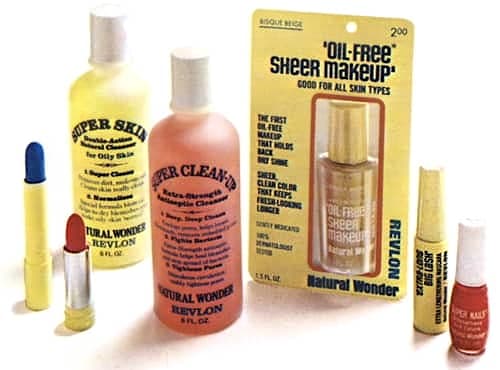
Above: 1973 Natural Wonder.
Unfortunately for Revlon, Cover Girl continued to erode Revlon’s sales in pharmacies, drug and chain stores where price-sensitive and younger women made most of their purchases.
5. Etherea
A few smaller cosmetic companies such as Almay Cosmetics (1931) and Ar-Ex Cosmetics (1935) had been producing cosmetics (sometimes described as hypo-allergenic) for customers with sensitive skin that were prone to reactions to fragrances and other notable allergens found in regular cosmetics. Revlon largely ignored this market until Estée Lauder introduced her Clinique line in 1968.
Clinique was a beautiful line. Handsomely packaged and even more handsomely priced, it promised the cosmetics buying consumer she would be getting products which were 100% allergy tested and 100% fragrance free. Every conceivable cosmetic was offered in this unique formulation from lipsticks to skin clarifiers.
(Abrams, 1977, p. 95)
Charles Revson’s response to Clinique was the Etherea line developed in 1969. Described by Revlon as ‘beginning where hypo-allergenics end’ the line never really gained much traction and, like Natural Wonder, it failed to put a dent in the targeted opposition. However, Revlon persisted with it and new products were added over the years including: Etherea Special Formula Lipstick (1971); and Etherea Excess Oil Blotting Gel (1972).
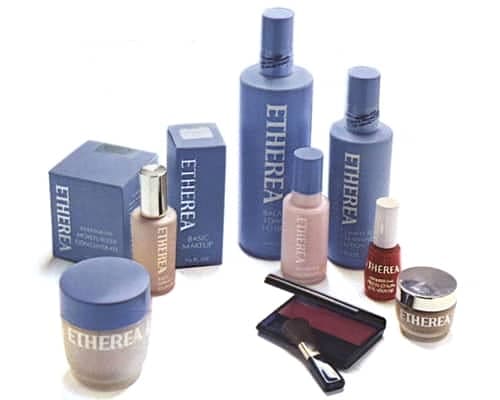
Above: 1973 Etherea.
The small size of the line can be judged by the fact that the Etherea Division became Etherea and Specialty Lines in 1971, and was then reorganised as Etherea/Fine Fragrances in 1973. I also note that Revlon acquired Almay along with a number of other cosmetic brands in 1986.
Estée Lauder
The development of Etherea was only one of a number of actions that Charles Revson took to counteract the encroachment of Estée Lauder. Abrams suggests that Revson had a certain admiration for Lauder that was not evident in his dealings with his two older adversaries, Helena Rubinstein and Elizabeth Arden.
Charles Revson admired Estee [sic.]. She was a woman who did things precisely in the style he agreed with – sophisticated, smart, emphasis on department stores and high prices, beautiful packaging, good fragrances, and slick advertising.
(Abrams, 1977, p. 95)
Revson tried to counter the growth of Estée Lauder by copying many of her products and advertising tactics.
[W]hatever Lauder did, Charles soon followed. She offered “gift with purchase”; he offered gift with purchase. She went to using a single model exclusively; he followed with Lauren Hutton for Ultima—and one-upped her by signing Richard Avedon as her exclusive photographer. She went to sepia ads; he went to sepia. She switched back from sepia; he switched back. She bought out a “stinky” fragrance (Charles’s word); he bought out a stinky fragrance. She brought out Aramis; he brought out Braggi. She brought out Clinique; he brought out Etherea. She brought out a fragrance called Estée; he brought out Charlie. To add insult to unoriginality, he put copied products in his less-than-Ultima lines, to cheapen the originals by association.
(Tobias, 1976, p. 249)
Although Lauder in the 1960s was nowhere near the size of Revlon, it operated in the part of the cosmetics market that was nearest and dearest to Charles Revson, namely department stores. Although maintaining department store space was expensive – as the manufacturer shares advertising and promotion costs, and sales salaries with the stores – cosmetics sold there were more prestigious. Revson’s concern about Revlon becoming less fashionable was the main reason behind the establishment of the Princess Marcella Borghese line in 1958, the first time Revlon had used a ‘celebrity’ endorsement; the opening of ‘The House of Revlon’ beauty salon in New York in 1961; and the revamping of the Ultima line as Ultima II in 1964.
6. Ultima II
Ultima II was the sixth line mentioned in the 1973 annual report and the third arm in Revson’s efforts to keep Revlon in the prestigious end of the cosmetic market. The line began with Ultima (1959), a nutrient night cream produced to compete with products such as Rubinstein’s Tree of Life (1958), Arden’s Crème Extrordinaire (1958) and the much older Charles of the Ritz’s Revenescence Cream, originally called Rejuvenescence.
As previously mentioned, an Ultima make-up collection was added in 1960 which included foundations, face powders, and lipsticks.
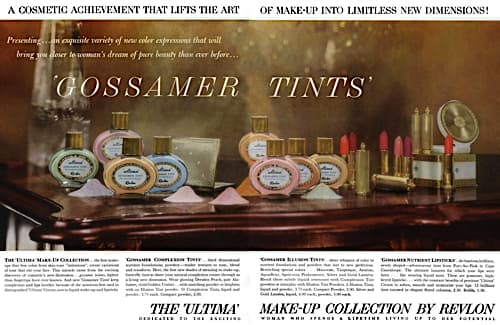
Above: 1960 Revlon Ultima Make-Up Collection.
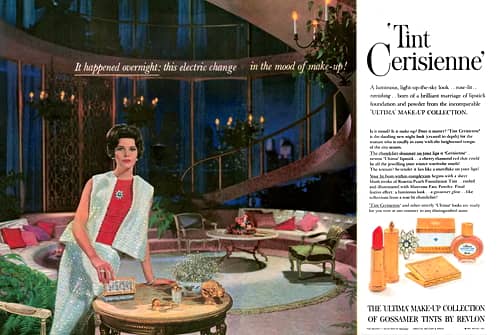
Above: 1961 Revlon Ultima Make-Up Collection ‘Tint Cerisienne’ – Cerisienne Lipstick coordinated with Rosetta Peach Foundation Tint and Mauvesse Face Powder.
The line did not do very well but, as usual, Revson persevered with it.
When Ultima was first put together … it was a flop. One ad showed the most obnoxious-looking spoiled, chubby kid in shorts and knee socks with his mother, who looked more uncomfortable than sexy, sitting on an overstuffed ottoman in an overdone living room … the idea apparently was to reach into Park Avenue’s poshest parlor—and it didn’t work. But Charles Revson, we all know by now, was not a man to give up. The products, packaging, and approach were all reworked, the line doggedly promoted, until eight years after its initial introduction it finally turned a profit.
(Tobias, 1976, p. 250)
In 1964, Ultima was overhauled and released as Ultima II. Starting with three make-up lines – Creme Foundation, Blushing Creme,and Face Powder – this was expanded to include items such as Nutrient Makeup, Pressed Powder Compact, Eyeliner Cake, Lash Makeup Automatic, Brow Makeup Cake, and Patina Eye Shadow.
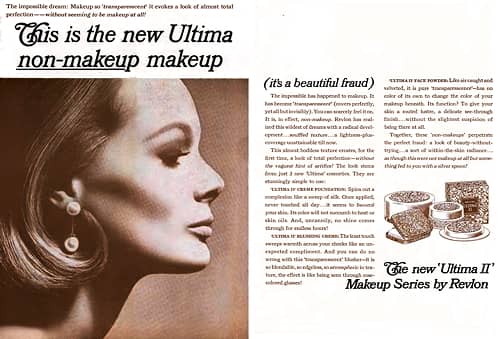
Above: 1964 Ultima II Make-Up Series: Ultima II Creme Foundation, Ultima II Blushing Creme, and Ultima II Face Powder.
In 1966, it was expanded to include a fragrance and a complete skin treatment line of twelve products. It eventually included products such as: Milky Facial Bath, Creamy Cleansing Concentrate, Lotion Refreshant, Under Makeup Moisture Lotion, Under Makeup Nutrient Creme (1966); Translucent Wrinkle Creme, Deep-Deep Cleansing Foam, and 3-Minute Foaming Facial (1968); Mineral Masque Concentrate; and Eye Creme Concentrate.
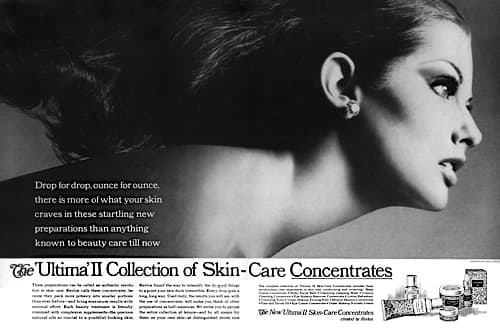
Above: 1967 Ultima II.
Ultima II has the distinction of being the first Revlon line to carry the personal endorsement of Charles Revson and to carry his name on the packaging. It was also the first Revlon range to use an exclusive modelling arrangement, the chosen model being Lauren Hutton [b.1943] who signed with Revlon in 1973.
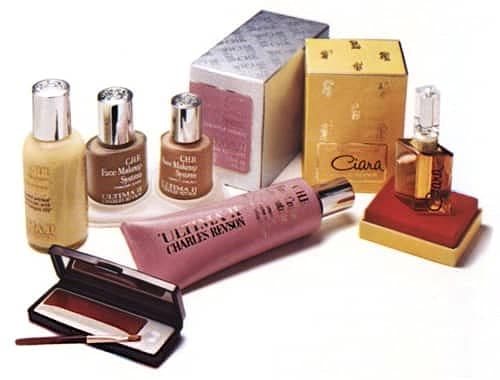
Above: 1973 Ultima II with Charles Revson’s name on the packaging.
None of these tactics saved Revlon from the encroachments of Estée Lauder. Her sales numbers continued to rise and would eventually outstripped Revlon’s.
Charlie
The Charlie range can be considered as Revlon’s seventh line. It was launched in 1974 following the success of the Charlie fragrance. Cosmetics in the line included a complete skin-care range and all the usual items associated with make-up.
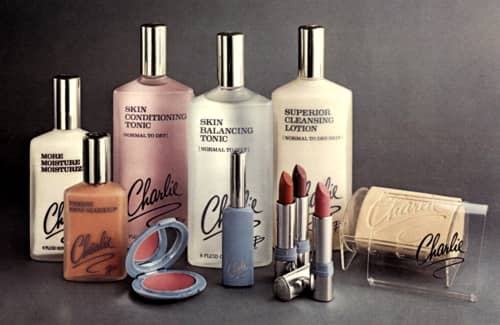
Above: 1974 The Charlie range, Revlon’s seventh cosmetics line.
The Revlon conglomerate
Revlon’s first overseas factory was established in England in 1950. By 1961, Revlon had manufacturing facilities in Mexico, England, Venezuela, Argentina, Australia, France, and South Africa, with Ireland, Japan and Israel added by 1963. By 1965, the company’s international operations had become its largest area of growth.
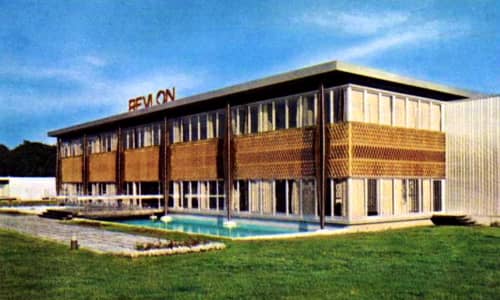
Above: 1965 Revlon factory in Japan. A lot of Revlon factories were built in this ‘Diamonds and Lace’ style.
Revlon also continued to acquire businesses that Revson hoped would maintain growth and reduce the company’s dependence on cosmetics. Some had a relationship with the beauty business – selling products like shampoos, hair dyes and wigs – but many did not, making products such as artificial flowers, dresses, plastics, toilet cleansers and room deodorisers. Revson was not an acquisition genius and most of his purchases proved to be less than successful, the one major exception being the U.S. Vitamin & Pharmaceutical Corporation which Revlon bought in 1966.
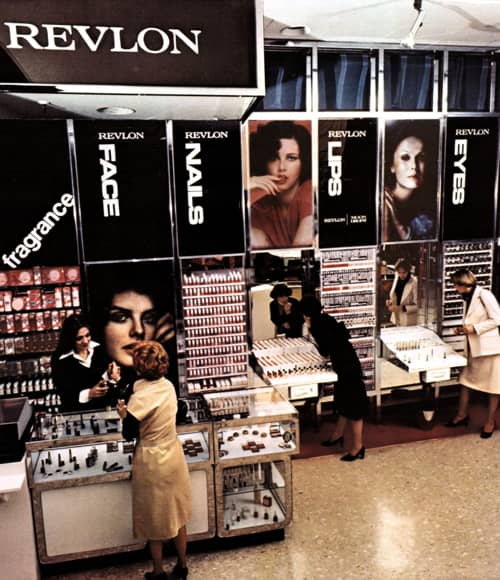
Above: 1976 Revlon retail stands.
The acquisition program was probably the main reason behind Revson selecting Michel Bergerac as his successor. Bergerac had been in control of International Telephone and Telegraph’s (ITT) European operations and had made a number of successful acquisitions for that company while he was there.
Later developments
When Charles Revson died in 1975, Revlon’s net sales were US$749,773,000 with net earnings of US$62,622,000. By 1984, with Bergerac at the helm, this had risen to US$2,399,205,000 and US$112,098,000 respectively.
In August, 1985, Revlon was subjected to a hostile takeover by Pantry Pride, and financed with junk bonds. The takeover was largely engineered by Ronald O. Perelman [b.1943], then Pantry Pride’s chairman and chief executive officer. Before it launched the takeover, Pantry Pride had signed agreements with Beecham Holdings to take over Revlon’s Norcliff Thayer (health products) and Reheis (specialty chemicals) for US$395 million in cash, and with the Beauty Acquisition Corporation to buy Revlon’s beauty division for US$905 million. In November, 1985, Pantry Pride then signed an agreement with Rorer Group, Inc. to buy Revlon’s USV Pharmaceuticals and Armour Pharmaceuticals for US$690 million in cash. These sales helped offset some of the US$2.7 billion Pantry Pride reputedly paid for Revlon but still burdened the company with a large amount of debt.
Revlon has lost most of the prestige it enjoyed in the 1950s and is now a mass-marketed brand operating in the upper range of large volume retailers.
Timeline
| 1960 | Realistic Company of Cincinnati, makers of professional beauty salon products, bought. Revlon Professional, aimed at the professional salon industry, established. New Products: Ultima make-up collection; Moon Drops line |
| 1961 | House of Revlon opened at 698 Fifth Avenue, New York. Revlon Hair Color Clinics and Training Centers set up in major American cities. Intimate and Aquamarine packaging redesigned. New Products: Eterna 27, skin cream; Contempera, matte finish make-up; Eye Velvet, moisturising fluid cream eye shadow; Super Lustrous II lipstick; and That Man After Shave Lotion and Talcum. |
| 1962 | Salon-Hair Color Division established. Revlon Research Centre, Inc. established in New York. Love-Pat repackaged. New Products: Natural Wonder medicated make-up; Blush-On, tinted blending powder; Wonder Cover, corrective spot make-up; Contempera special formula for dry skin; Moon Drops Extra Emollient Moisture Balm for dry skin; Sculptura slim line lipstick; Flex protein treatment for hair. |
| 1963 | Manufacturing and sales established in Japan. New Products: Fabulash, lash lengthener and mascara. |
| 1964 | Belvedere Products, makers of salon equipment and Belmont Laboratories (Mazon Dermatologicals) bought. New Products: Wonderlift, Natural Wonder Medicated Cake Make-up; Natural Wonder Disposable Medicated Cleansing Pads; Natural Wonder Total-Care Skin Lotion; Natural Wonder Medicated Blemish Stick; Moon Drops Moisture Balm for Dry, Dry Skin; Moon Drops Toning Lotion for Sensitive Skin; Moon Drops Moisturizing Bath Oil; Moon Drops Facial Mask; Moon Drops Lipstick; Eterna 27 Treatment Collection; and Ultima II make-up line. |
| 1965 | Revlon sells Schick Electric, Inc. New Products: Sweeping Beauty make-up; Colorsilk home hair colourants; and Pub Cologne, After-Shave, and Cologne Spray. |
| 1966 | U.S. Vitamin & Pharmaceutical Corporation, Parfums Raphael SA, France (including Parfums Marcy, Inc. their U.S. distributor) acquired. New Products: Under Make-up Nutrient Crème; Frostlings lipstick; Crystalline nail enamels; Blondsilk home hair toner; Sunnyside Up, a shampoo hair lightener; Moon Drops Blushing Silk moisturiser plus colour; Ultima II expanded to include a fragrance and complete skin treatment line; Private Eyelashes; and Braggi line of toiletries for men. |
| 1967 | New Products: Face Gleamer, a transparent blusher; Moon Drops Demi-Makeup; Ultima II Transparent Face Tints, Lip Tints, Nail Tints and Shadow Tints; Natural Wonder oil-free products for oily or blemished skin; Patina Eye Shadows; and body treatments added to Princess Marcella Borghese. |
| 1968 | Revlon’s Professional Products division moves to New York. Cosmetics and Fragrance Division established. Revlon Development Corporation established. New Products: Moon Drops Demi Facecare and Lipsticks; Natural Wonder Flowing Lotion, Blotting Powder, Blotting Blusher and Un-Lipsticks; Transparents, a nail enamel; Ultima II Translucent Wrinkle Creme, Deep-Deep Cleansing Foam and 3-Minute Foaming Facial; Touch & Glow liquid make-up in a roll-on; and Cream Concealer cover cream. |
| 1969 | Revlon Eye Makeup line repackaged. New Products: Etherea, a hypoallergenic line; Young Blush, transparent face powder; Moon Drops Luminesque Cream Blusher; Ultima II Perfect Make-up, Eyecontoure 70; and Natural Wonder acne treatments and hypoallergenic make-up. |
| 1970 | Mitchum Company bought and merged with Thayer Laboratories to form the Mitchum-Thayer Division. New Products: Ultima II Body Couture Collection, Eye Couture Collection and Perfect Make-Up for Nails; Moon Drops Luminesque frosted lipsticks; and Natural Wonder Great Glisteners lipsticks. |
| 1971 | New Products: Revlon Colorshine lipstick, Natural Herb Cleanser, Natural Honey Lotion; Natural Wonder Glisstick lipstick and Soft Blush; Etherea Special Formula Lipstick; Ultima II Skim Milk Natural/Organic Skincare; Borghese Garden Collection; and Flex Balsam & Protein Shampoo and Conditioner |
| 1972 | House of Revlon closes. New Products: Ultima II Super Luscious Lipstick; Princess Marcella Borghese Roman Gold collection; and Etherea Excess Oil Blotting Gel. |
| 1973 | Revlon contracts the model Lauren Hutton as its first face. Acquires Deluxol Laboratories, the maker of hair products for African Americans. New Products: Charlie fragrance; Moon Drops Complete Skincare Series and All-Weather Cream Blush; Ultima II C.H.R. Skincare Concentrates with collagen 100; Natural Wonder Shiny Eyeshadow Crayon and Super Nails; and Revlon Milk Plus 6, shampoo, cream rinse and conditioner. |
| 1974 | Borghese line repackaged. New Products: Charlie line; Touch & Glow Moisture Cream and Frosted Make-up; Moon Drops Multiple Moisture Action; and Natural Wonder Shiny Lip Color Crayons, Frosted Lip Color Crayons and Eye Shadow Crayon Pencils. |
| 1975 | Charles Revson dies and Michel Bergerac assumes the leadership of Revlon. |
| 1977 | Carlos Colomer, a Spanish professional beauty supply distributor acquired. |
| 1985 | Revlon taken over by Pantry Pride, a subsidiary of Ronald Perelman’s MacAndrews & Forbes Holdings, and becomes a private company. Bergerac leaves. Non-cosmetics businesses sold off. |
| 1986 | Pantry Pride changes its name to Revlon Group, Inc. Playtex beauty division (includes Max Factor, Almay and Halston Fragrances) bought. |
| 1987 | Revlon Group, Inc. goes public. Germaine Monteil Cosmetiques acquired from Beecham. Parts of Lanvin-Charles of the Ritz, Inc. acquired from Yves Saint Laurent. |
| 1989 | Betrix Cosmetics GmbH bought. |
| 1990 | Revlon bank loans restructured. |
| 1991 | Germaine Monteil and Lancaster sold to Jon A. Benckiser GmbH (West Germany). Max Factor & Co. and Betrix GmbH sold to Procter & Gamble. Clean-Clear skin care range sold to Johnson & Johnson Products, Inc. |
| 1992 | Princess Marcella Borghese and Halston Enterprises sold to a Saudi investment group. |
| 1996 | Revlon makes a public offering of stock. |
| 2000 | Revlon’s professional products line and Natural Wonder sold to companies formed by the private equity firm CVC Capital Partners. |
First Posted: 10th January 2012
Last Update: 14th April 2023
Sources
Abrams, G. J. (1977). That man: The story of Charles Revson. New York: Manor Books, Inc.
Revlon. (1964). Revlon’s skin care guide for teens [Booklet]. U.S.A.: Author.
Revlon. (c.1964). The complete guide to skin care by Revlon [Booklet]. U.S.A.: Author.
Revlon. (c.1965). The complete guide to make-up by Revlon [Booklet]. U.S.A.: Author.
Revlon. (c.1965). The Revlon guide to beauty treatment [Booklet]. England: Author.
Revlon. (c.1965). Revlon tips on shade selection [Booklet]. U.S.A: Author.
Revlon. (1966). Revlon guide to nail care [Booklet]. U.S.A: Author.
Revlon, Inc. Annual Reports 1961-1984.
Tedlow, R. S. (2003). Giants of enterprise. Seven business innovators and the empires they built. New York: HarperCollins Publishers, Inc.
Tobias, A. (1976). Fire and Ice: The story of Charles Revson—the man who built the Revlon empire. New York: William Morrow.
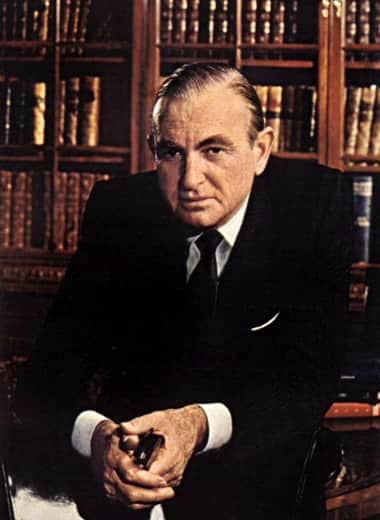
Charles Revson [1906-1975] aged around 50 and chairman of the board of Revlon.
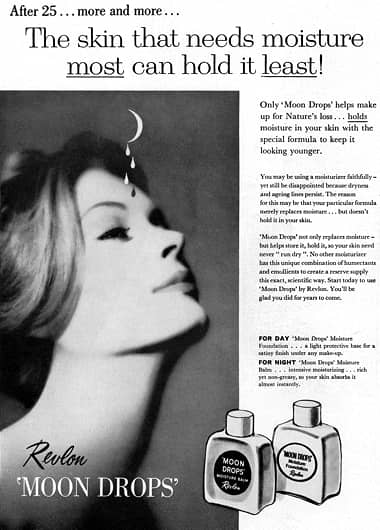
1960 Revlon Moon Drops.
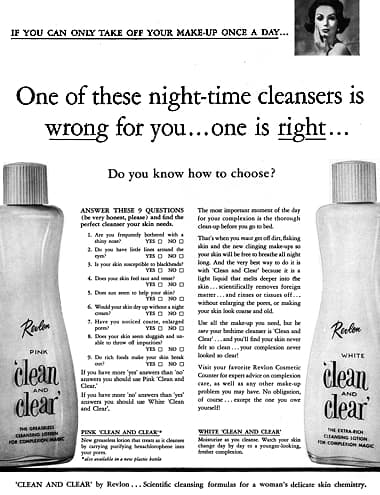
1960 Revlon Clean and Clear.
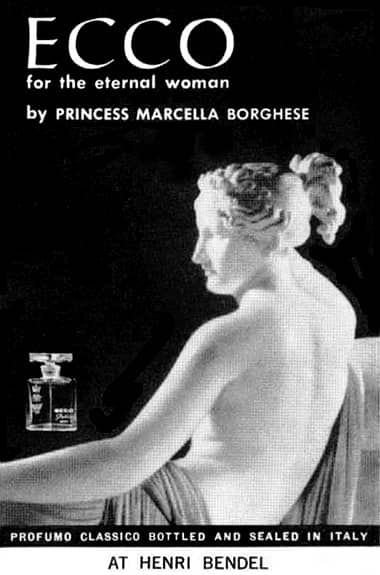
1960 Ecco by Princess Marcella Borghese. Note that it does not say made in Italy.
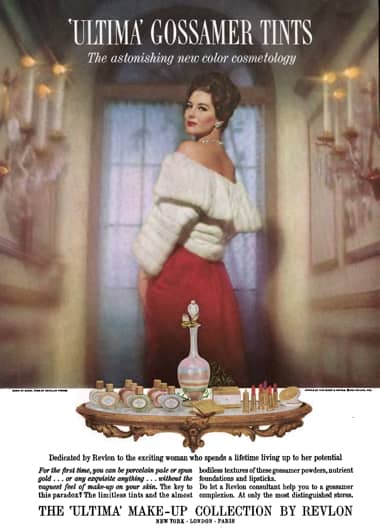
1961 Revlon Ultima Make-Up Collection.
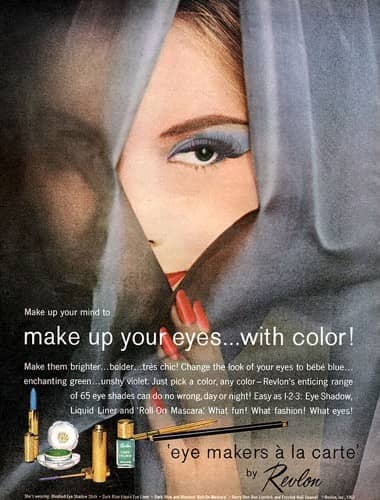
1961 Revlon Eye Makers.
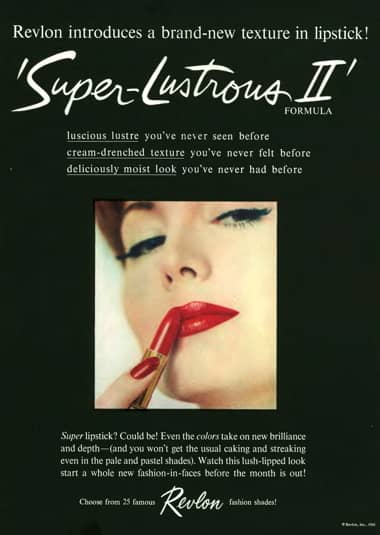
1961 Revlon Super-Lustrous II lipstick in 25 of Revlon’s best selling shades.
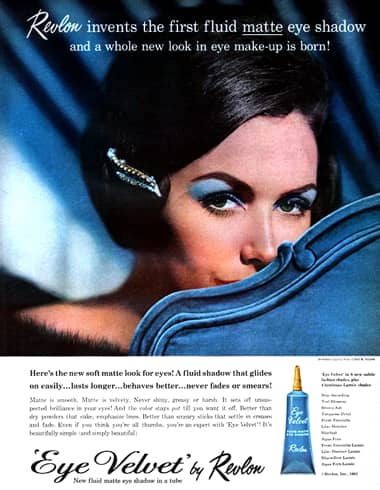
1961 Revlon Eye Velvet in eight fashion and four Lameé shades. By 1964 the shade range included: Blue Snowdrop, Bluebud, Teal Blossom, Aqua Fern, Pale Pistachio, Fresh Emeralds, Softly Beige, Tender Taupe, Dove Grey Brown Ash, Bluewillow Lameé, Aqua Fern Lameé, Fresh Emeralds Lameé, and Alabastre Lustre Lameé.
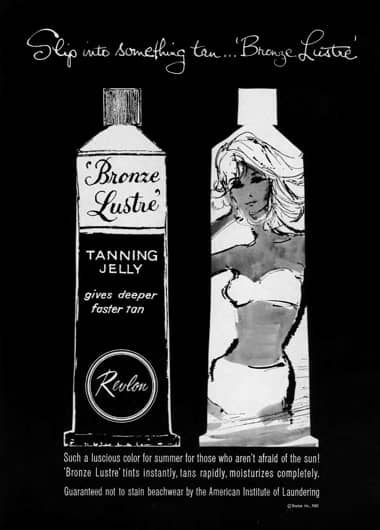
1961 Revlon Bronze Lustre.
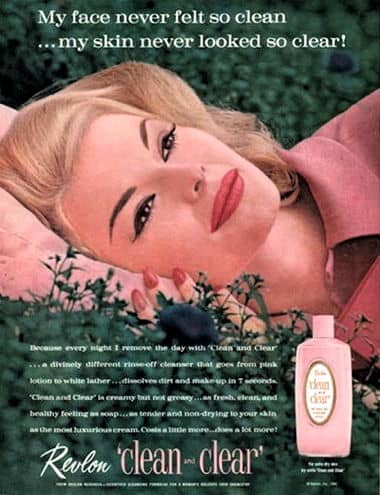
1961 Revlon Clean and Clear.
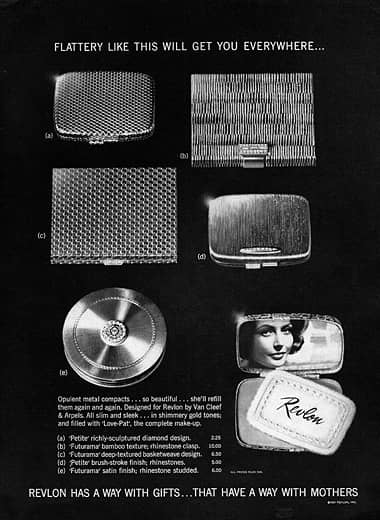
1961 Revlon Compacts.
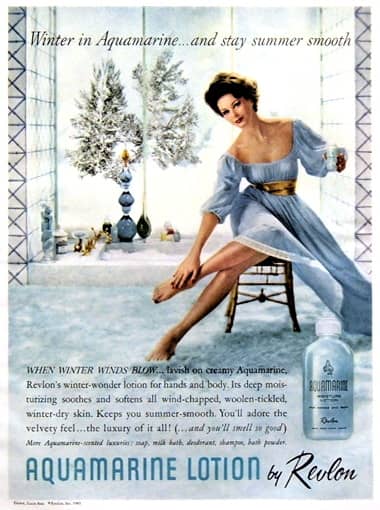
1961 Revlon Aquamarine Lotion.
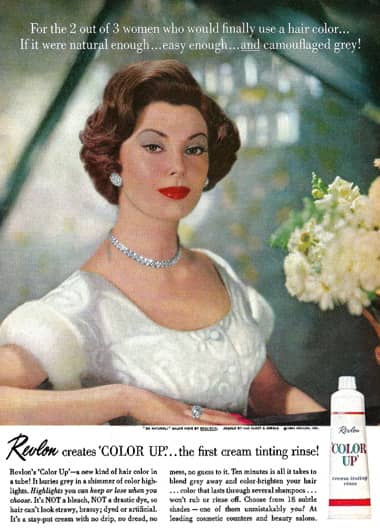
1961 Revlon Color Up, cream hair tinting rinse.
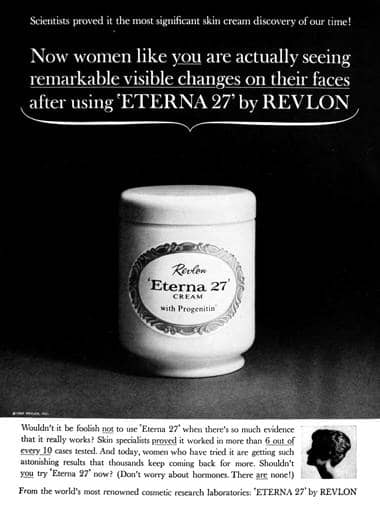
1962 Revlon Eterna 27.
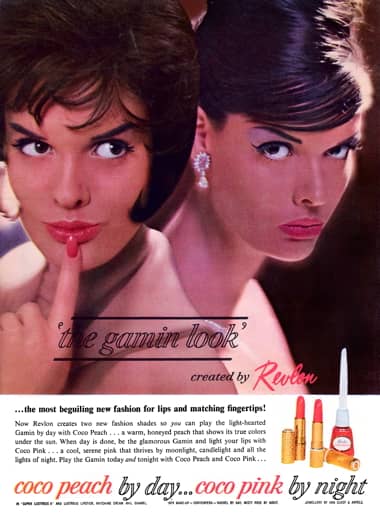
1962 Revlon Coco Peach and Coco Pink (Australia). These shade names were not used in the United States.
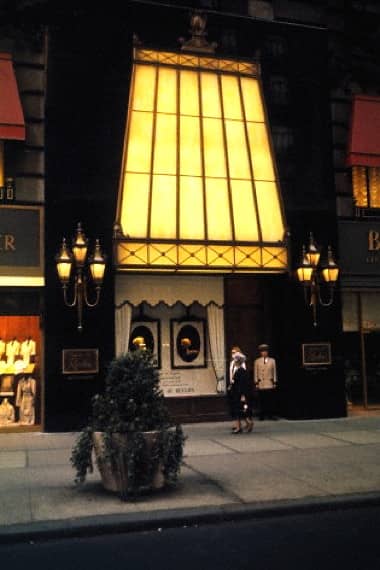
1962 Exterior view of the House of Revlon. The big glass doors were too big for many women to open which meant that management had to employ a doorman.
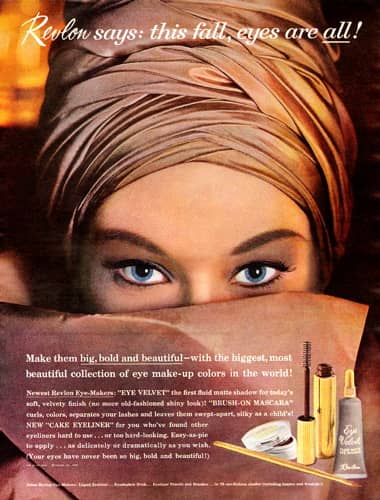
1962 Revlon Eyemakers: Eye Velvet, Cake Eyeliner and Brush-On Mascara.
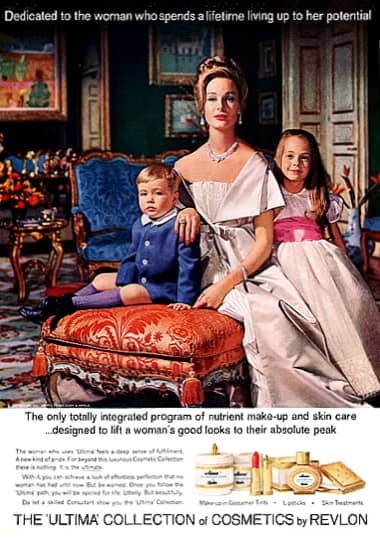
1962 Revlon Ultima Collection of Cosmetics. The advertisement with “the obnoxious-looking spoiled, chubby kid in shorts and knee socks with his mother, who looked more uncomfortable than sexy, sitting on an overstuffed ottoman in an overdone living room” (Tobias, 1976, p. 250).
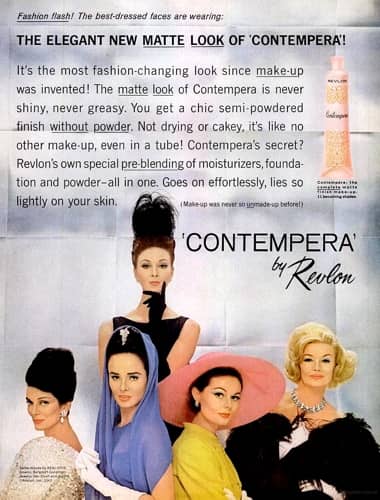
1962 Revlon Contempera matte look make-up. A liquid blend of powder, moisturiser and foundation in a tube. Introduced in 1961, a special formula for dry skin was added in 1962.
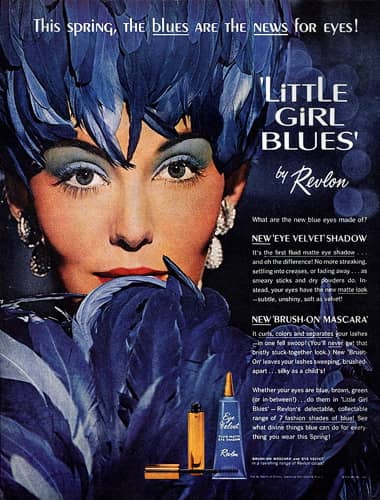
1962 Revlon Eye Velvet Shadow and Brush-On Mascara.
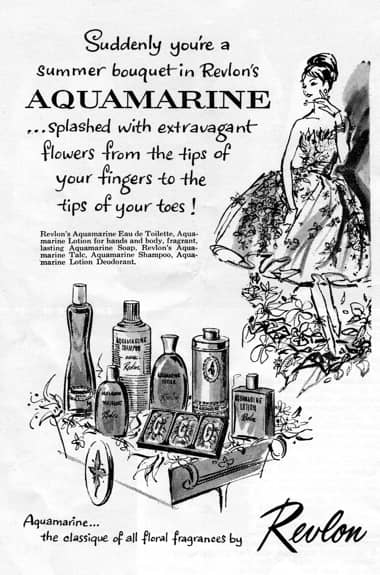
1962 Revlon Aquamarine (Australia).
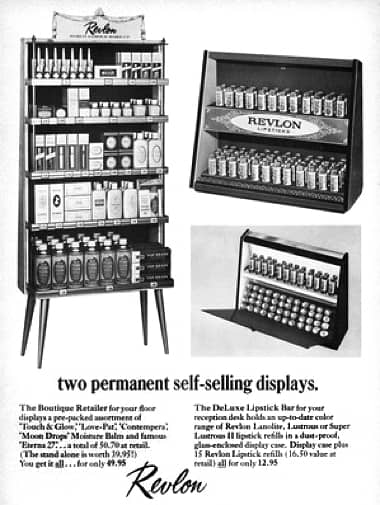
1963 Revlon Display Cases. Left: Nail Enamels, Lipsticks, Touch & Glow, Love Pat, Contempera, Moon Drops Moisture Balm and Eterna 27. Right: Lanolite, Lustrous and Super Lustrous II Lipsticks and refills.
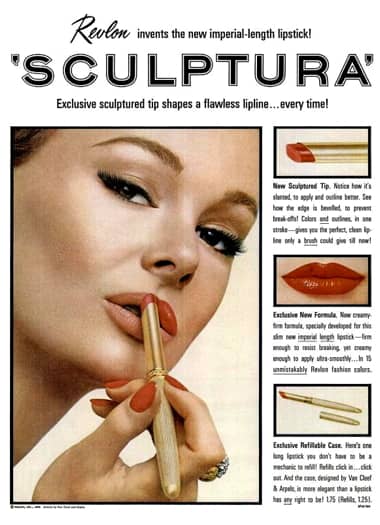
1963 Revlon Sculptura Lipstick, Revlon’s second attempt at a long lipstick.
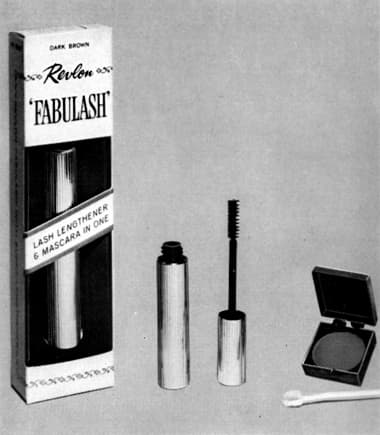
1963 Revlon Fabulash Mascara and Fabulash Lash Base a separate ‘super-lengthener’ that could be applied under the mascara for additional length.
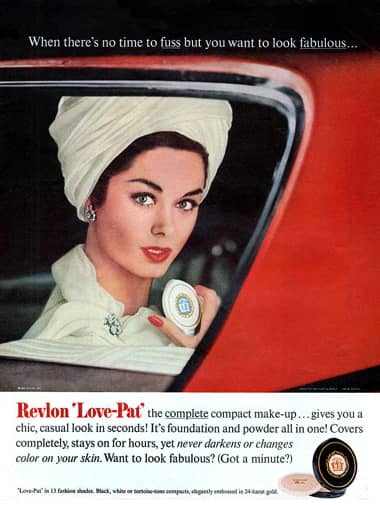
1963 Revlon Love Pat.
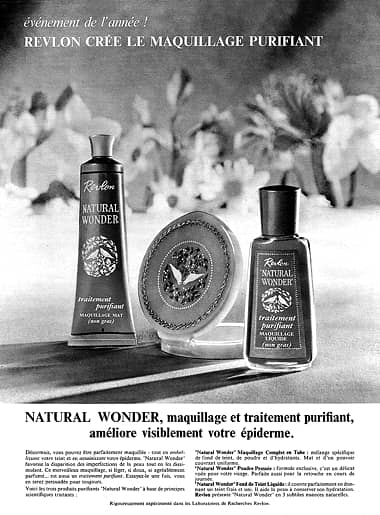
1963 Revlon Natural Wonder Matte Make-up, Pressed Powder, Liquid Make-up in 5 shades (France).
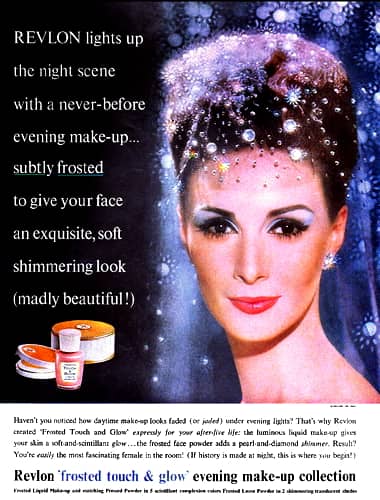
1963 Revlon Frosted Touch and Glow.
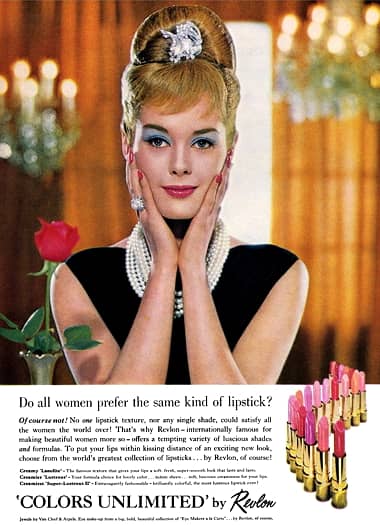
1963 Revlon Colors Unlimited in Lanolite, Lustrous and Super Lustrous II.
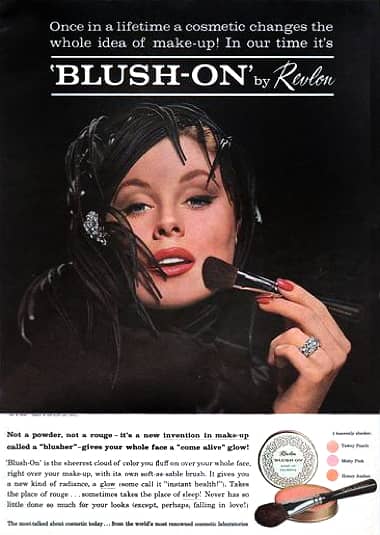
1963 Revlon Blush-On.
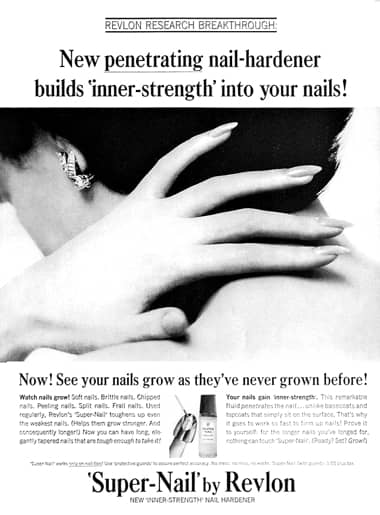
1964 Revlon Super-Nail.
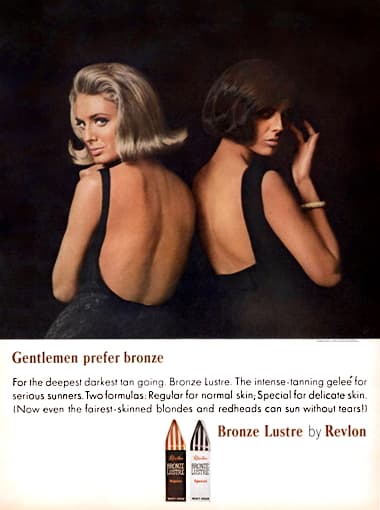
1964 Revlon Bronze Lustre.
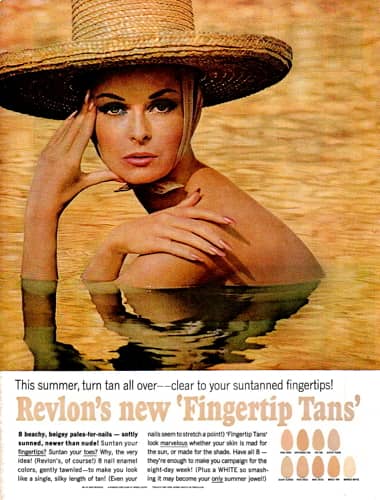
1964 Revlon Fingertip Tans. Shades: Pink Sand, Driftwood Tan, Tan Tan, Butter Pecan, Sugar Blonde, Rose Gold, Bare Beige, Barley Tan and Bamboo White.
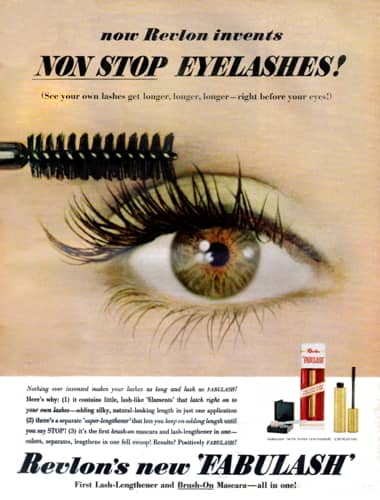
1964 Revlon Fabulash Mascara. Revlon also sold Fabulash Lash Base a separate ‘super-lengthener’ that could be applied under the mascara for additional length.
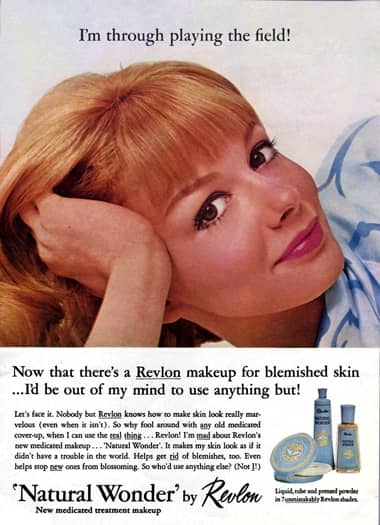
1964 Revlon Natural Wonder.
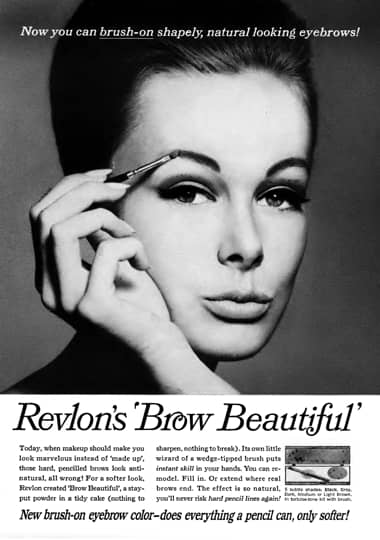
1964 Revlon Brow Beautiful.
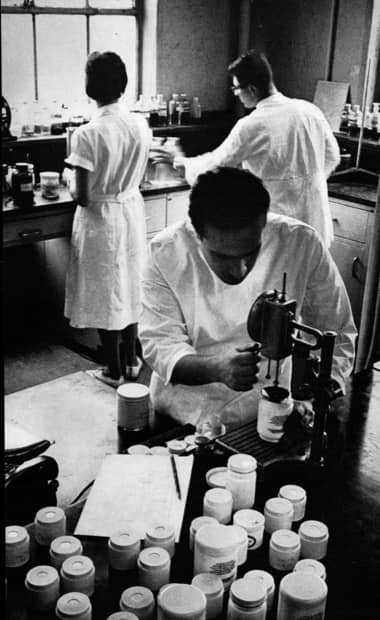
1964 Quality control in the new Revlon Research Center established in 1962 at 745 Zerega Ave, in the Bronx, New York.
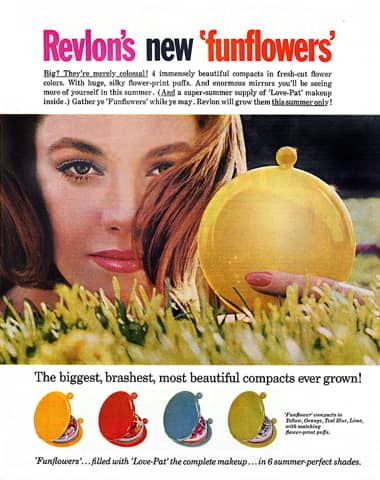
1964 Revlon Funflowers compacts.
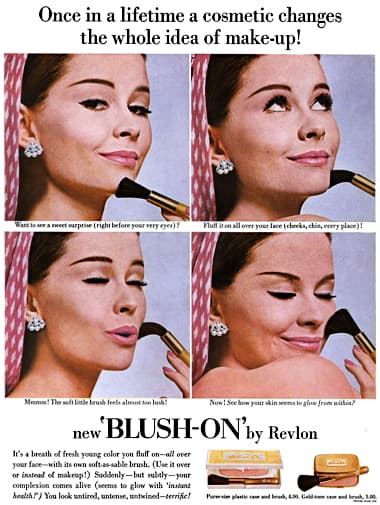
1964 Revlon Blush-On.
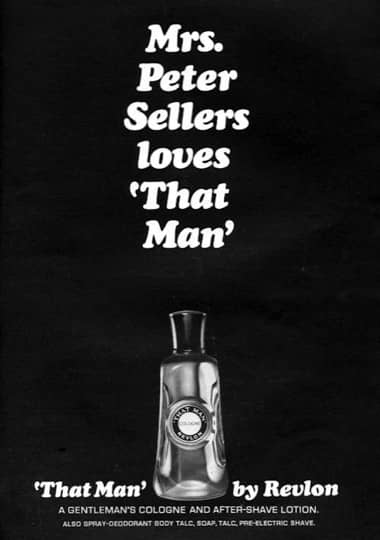
1965 Revlon That Man Cologne and Aftershave.
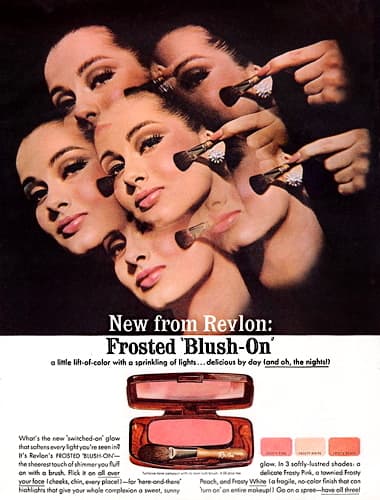
1965 Revlon Frosted Blush-On in Frosty Pink, Frosty White and Frosty Peach shades.
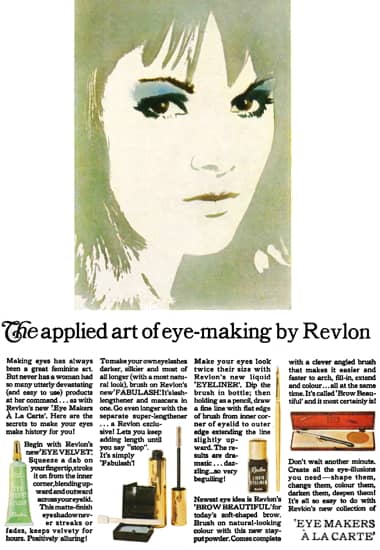
1965 Revlon Eye Makers.
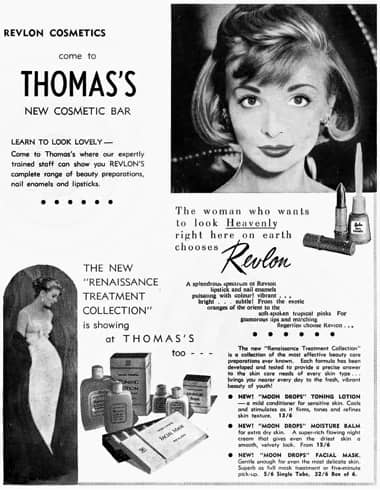
1965 Revlon Lipsticks and Nail Enamels and Renaissance Treatment Collection (Australia).
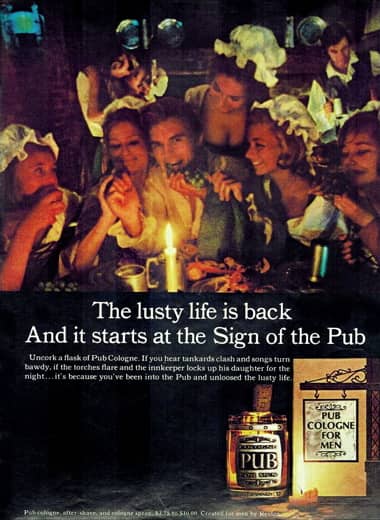
1965 Revlon Pub Cologne.

1965 Revlon Frosted Blush-On in Frosty Pink, Frosty White and Frosty Peach shades.
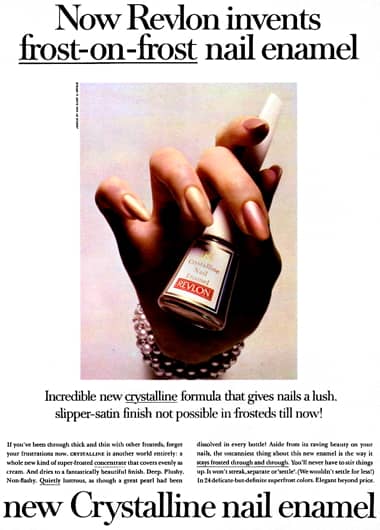
1966 Revlon Crystalline Nail Enamels in Almond Ice, Sugar Bisque, Candied Violet, and Platinum shades.
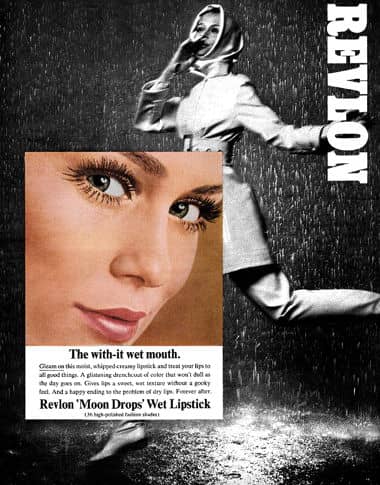
1967 Revlon Moon Drops Wet Lipstick.
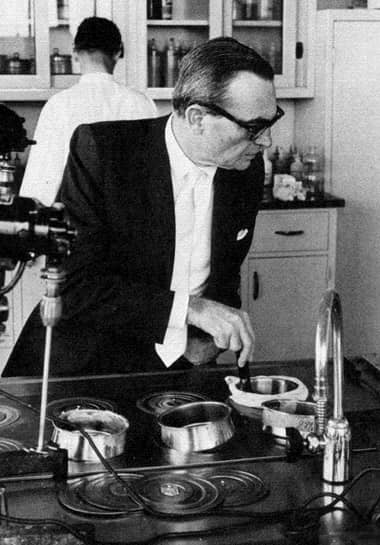
Charles Revson in the Revlon laboratory. Tuesday was lab day for many years (Tobias, 1976).
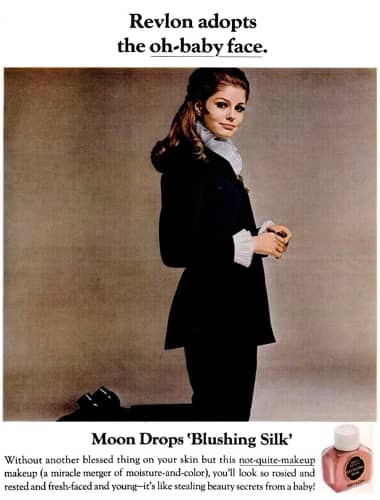
1967 Revlon Moon Drops Blushing Silk.
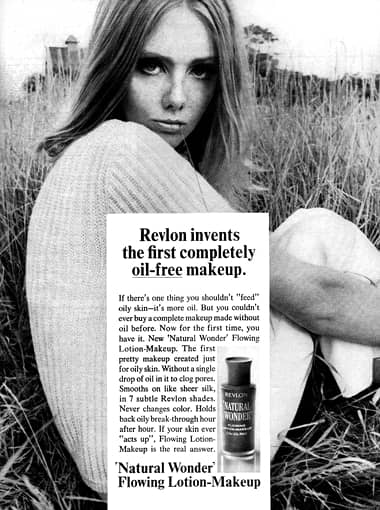
1968 Revlon Flowing Lotion.
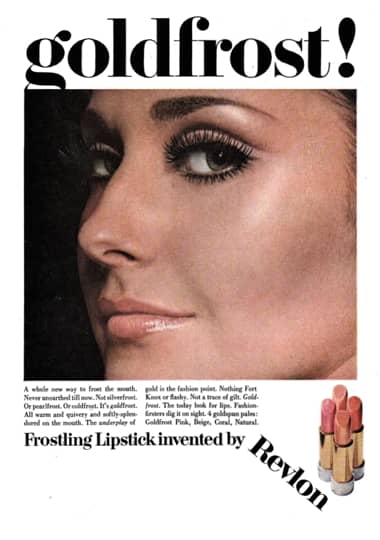
1968 Revlon Goldfrost Lipstick in Pink, Beige, Coral and Natural shades.
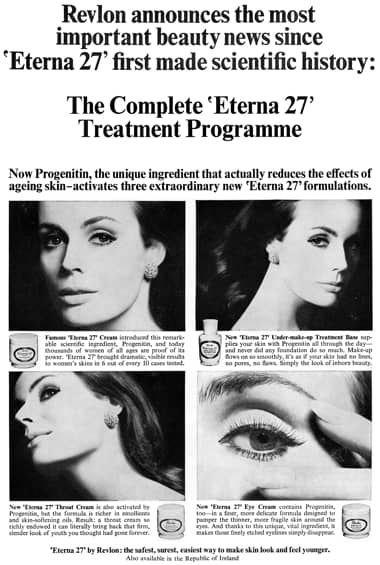
1968 Revlon Eterna 27 Treatment Program: Cream, Under Make-Up Treatment Base, Throat Cream, and Eye Cream (Australia).
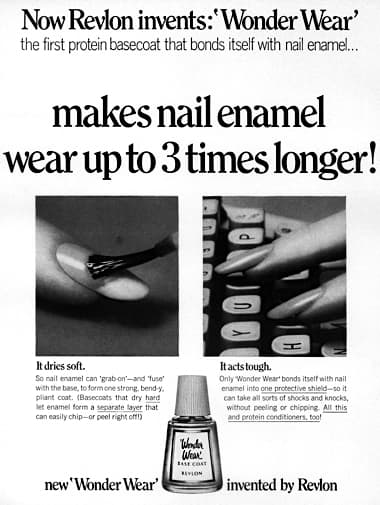
1969 Revlon Wonder Wear Base Coat.
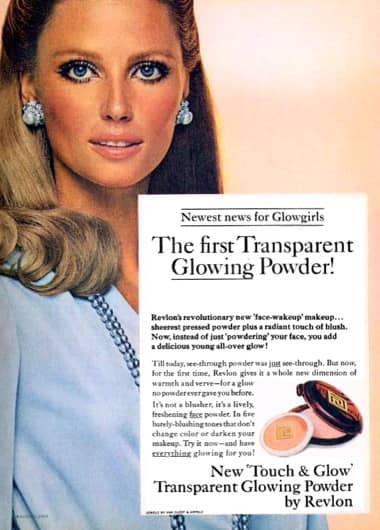
1969 Revlon Touch & Glow Transparent Glowing Powder.
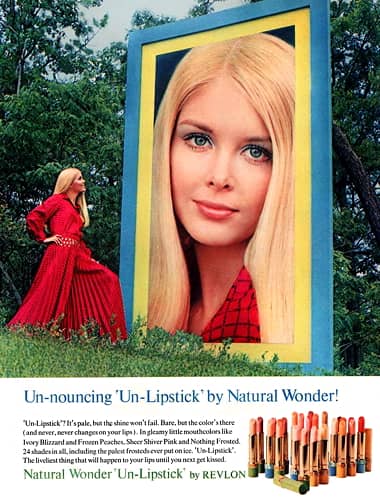
1969 Revlon Natural Wonder Un-Lipstick.Shades: Nothing, Nothing Frosted, Skinnylip Pink, Grapewine, Orange Peel, Great Granny Red, Polarbare Pink, Come Heather, Lickety Pink, Sweet Potato, Gingerale, Georgy Pink, E.S. Pink, Pithy Peach, Apricot, Enough Buff, and In the Flesh
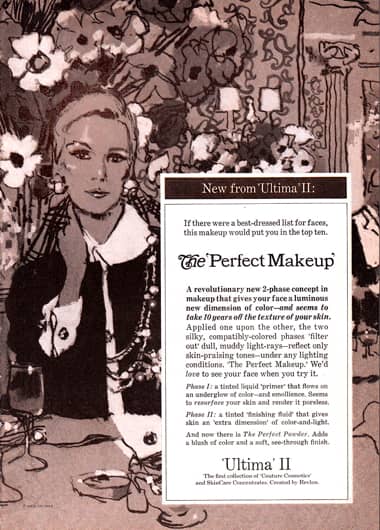
1969 Revlon Ultima II Perfect Make-Up.
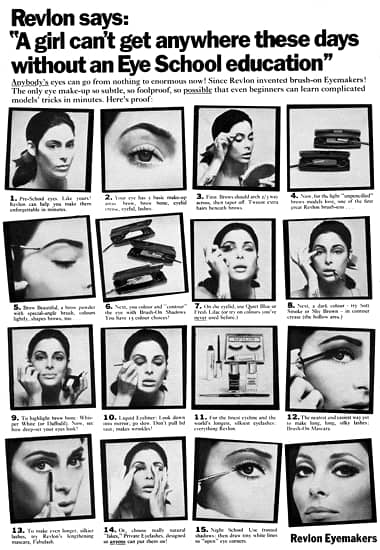
1969 Revlon Eye Makers.
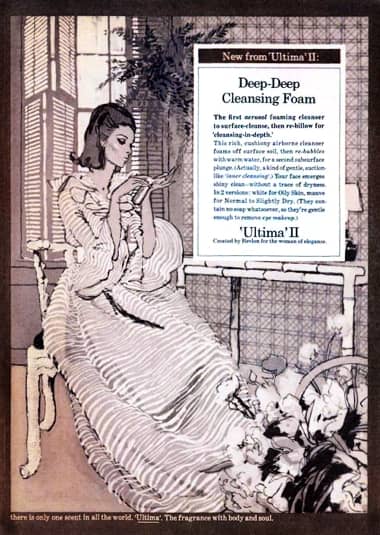
1969 Revlon Ultima II Deep-Deep Cleansing Lotion.
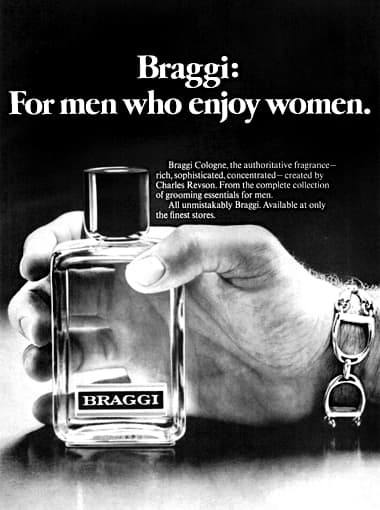
1972 Revlon Braggi.
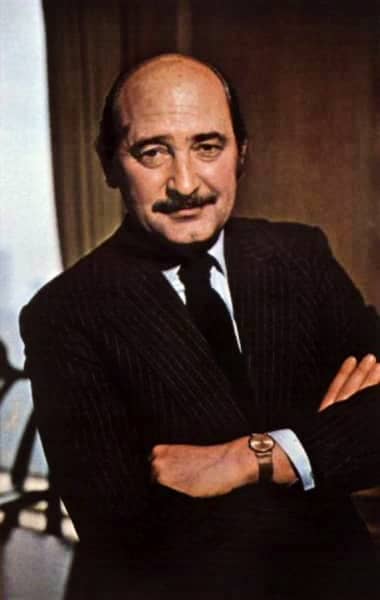
Michel C. Bergerac [1932-2016]. When Revlon was taken over in 1985 he left with a US$36 million payout.
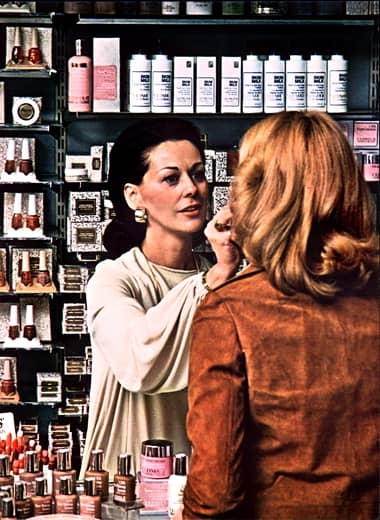
1974 Revlon counter.
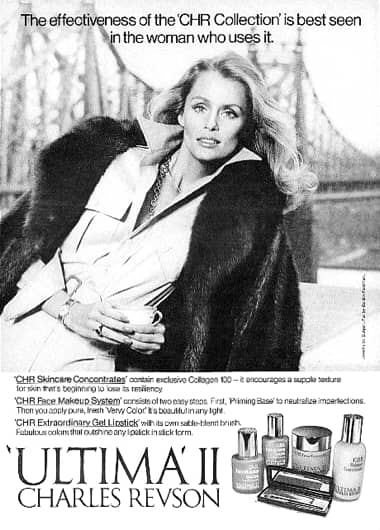
1976 Revlon Ultima II as endorsed by Charles Revson – CHR stands for Charles Haskell Revson. The model is Lauren Hutton, Revlon’s first official ‘face’.
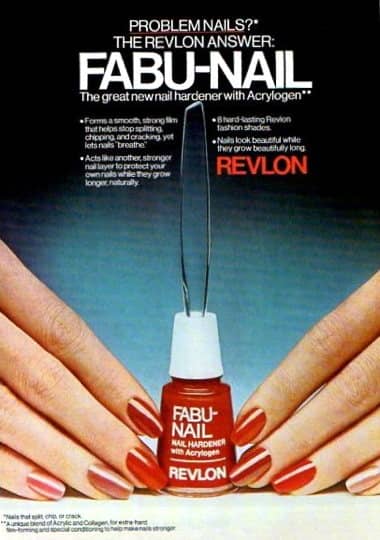
1977 Revlon Fabunail.
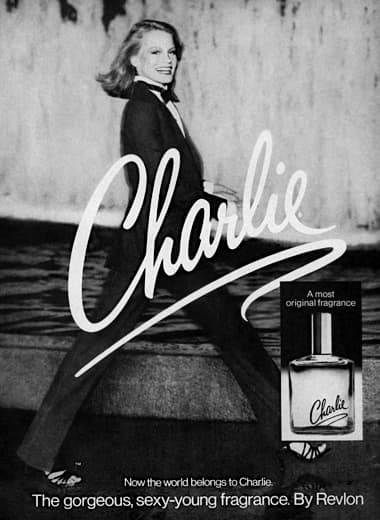
1977 Revlon Charlie.
